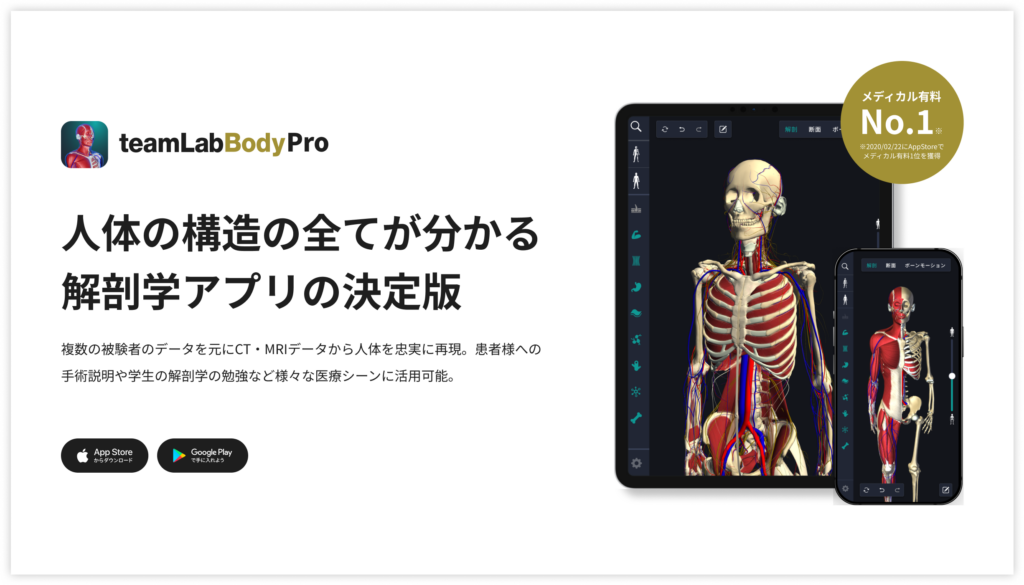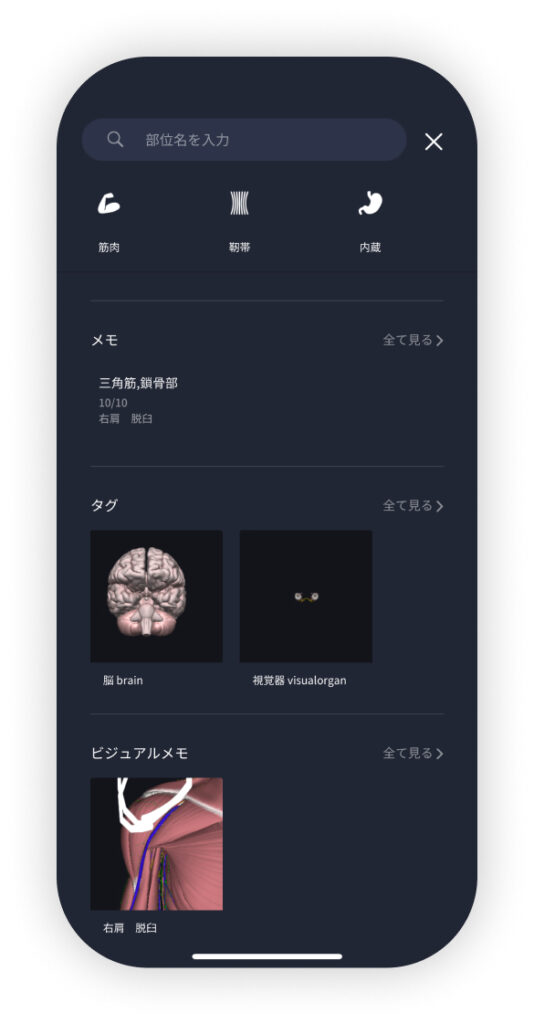beginning
In this article, I will explain effective study methods, starting with knowledge of specialized parts in human anatomy.
In human anatomy, it is necessary not only to memorize the names of various organs, muscles, and bones, but also to remember where they are located in the body. Therefore, it is necessary to learn as efficiently as possible.
I hope you can read this article and use the app to deepen your understanding even a little bit.
Now, I will explain the contents of the “superficial lymphatic upper limb” and how to study human anatomy.
teamLab Body Pro Free Download
A 3D anatomy app that shows all the structures of the human body
Download teamLab Body Pro here!

What is the upper extremity of superficial lymphatic vessels?
In the anatomy application, you can view a selection of anatomy 3D models. In this model, there are various observation methods such as surfaces, cross-sections, and nervous systems. This time, I'll explain using an anatomy application.
About the upper extremity of superficial lymphatic vessels

Superficial lymphatic vessels are important structures in the upper limbs and are mainly responsible for lymphatic drainage. Anatomically, superficial lymphatic vessels are located directly under the skin and are also called superficial cutaneous lymphatic vessels. The main function of these lymphatic vessels is to carry intertissue fluid, waste products, and foreign matter into the lymph nodes. The network of superficial lymphatic vessels in the upper extremities is complex and extends from the fingertips to the forearms and upper arms. These lymphatic vessels first reach relatively small lymph nodes and then gather in larger lymph nodes to be cleaned. Specifically, it starts at the back of the hand, is distributed to the palmar and dorsal sides of the forearm, and then flows towards the ulnar and radial lymph nodes of the upper arm. It eventually collects in the axillary lymph node group located in the armpit. In the superficial lymphatic vessels of the upper extremities, there is an important lymph node located near the elbow. These are particularly prone to swelling when there is an abnormality in the forearm or hand. Seen from an anatomical point of view, the running of lymphatic vessels is often parallel to the running of major blood vessels, and they are closely adjacent to vascular branches and cutaneous nerves. This arrangement indicates that lymphatic vessels can be affected over a wide area during inflammation or trauma. Thus, the function of superficial lymphatic vessels and their arrangement play an essential role in maintaining the health of organs and tissues.
Study points
Location and structure of the upper extremities of the superficial lymphatic vessels
The superficial lymphatic vessels of the upper extremities have a fine tubular structure that flows just below the skin and mainly transports lymph. These ducts are distributed in a network over a large area of the upper limb and run from the fingertips of the hands through the arms to the lower part of the shoulder. Superficial lymphatic vessels often run parallel to the superficial veins and flow close to the skin. Lymphatic vessels that flow out of the back of the hand join the cubital lymph node located in the medial elbow socket through the forearm, and then advance toward the shoulder from there. In the upper arm, these ducts also pass through the ulnar and radial lymph nodes and eventually flow into the axillary lymph node group. The structure of this lymphatic vessel is designed so that it can perform a function of trapping cells and foreign matter while being provided with special valves so that lymph can flow in one direction. The outer wall of lymphatic vessels is flexible, and it is possible to effectively transport lymph from tissues by exercising surrounding muscles. Thus, it works in conjunction with the circulatory system to help excrete waste products and foreign matter, and is responsible for part of the body's defense mechanism. The location and structure of superficial lymphatic vessels contribute to the efficient function of the entire lymphatic system, and are closely related to maintaining skin health and immune function.
The role and function of the upper extremity of superficial lymphatic vessels
The superficial lymphatic vessels of the upper extremities play an important role in the body's defense system. Its main role is to collect waste products, cell debris, and foreign matter along with intertissue fluid and transport them to lymph nodes. This process is essential for maintaining fluid balance and maintaining tissue health. Superficial lymphatic vessels are equipped with valves to allow lymph to flow in one direction, and the surrounding muscles contract to push lymph forward. Lymph provides a pathway for cleaning up foreign matter and waste in the body, and also plays a role in helping immune system cells identify and respond to these foreign substances. Also, when infection or inflammation occurs, superficial lymphatic vessels increase lymph flow in that area and rapidly carry out the process of eliminating foreign substances and pathogens through lymph nodes. For example, when trauma or infection occurs, nearby lymphatic vessels increase lymph flow and quickly carry away foreign matter, thereby strengthening the body's defenses. The role and function of these lymphatic vessels is directly linked to maintaining a healthy state, and they function as a physiological clean-up system in the body. When problems or damage occur, the effects are often expressed in the risk of lymphedema or infection. The normal function of the superficial lymphatic vessels is key to protecting health, and is particularly important in surgical and post-traumatic care.
English notation for upper extremity of superficial lymphatic vessels
The English notation for superficial lymphatic vessels is “superficial lymphatic lymphatic vessels of the upper limb,” and I will break down their components and explain them. First, “superficial” has the meaning of “superficial” or “shallow,” and in anatomy it indicates a structure close to the body surface. This term indicates that the lymphatic vessels are located close to the skin and not deep in the body. Next, “lymphatic” refers to something related to “lymph,” meaning a structure belonging to the lymphatic system. The lymphatic system supports immune function and plays an important role in maintaining fluid balance in the body. Next, “vessel” means “vessel” or “tube,” and here we show tubular structures for carrying lymph, that is, lymphatic vessels. This term is a term commonly used for blood vessels and lymphatic vessels. Finally, “upper limb” refers to the “upper limb,” which means the part of the body from the shoulders to the hands. “Upper” means “upper,” and “limb” means “limb” or “limb.” This phrase is used to identify a specific area of the body, that is, the entire arm. Combining these words, “superficial lymphatic vessels of the upper limb” refers to lymphatic vessels that run close to the surface of the upper limb. Each term is structured to specifically describe its function or location.
How to study human anatomy
I will explain specific study methods using human anatomy applications.
Check your past learning history and practice repeatedly
Here are the steps to check your anatomy learning history and practice iteratively effectively.
1. Check your learning history in the app
Reviewing your learning history with the application is an important step in effectively advancing anatomy learning. First, launch the app and go to the learning history section from the main menu. Many anatomy apps are designed to show your progress in the form of graphs and lists, so you can visually check which parts you've learned about and how much time you've spent.
By using this data, you can understand which areas you have strengths in and where you need to spend more time and effort. We also recommend using a dedicated tag or notebook function to mark areas you are particularly weak at or where you need to relearn. Regularly checking your learning history and looking back on past learning content will lead to efficient review and deepening understanding.
2.Make a plan for iterative learning
Making an efficient repetitive learning plan based on learning history is extremely effective in promoting knowledge retention. First, identify weak points and areas where you need to relearn. Next, arrange these study items into a weekly or monthly calendar and create a specific study schedule. By proceeding in a planned manner, you can learn each part evenly and avoid packing in a large amount of information at once.
Using a task management app or digital calendar to set study reminders is effective. Also, it's important to have the flexibility to regularly review progress and revise plans as needed. By having goals and proceeding with your studies in a planned manner, you can efficiently acquire anatomical knowledge.
3.Use 3D features to learn visually
By utilizing the 3D function, learning anatomy is easier to understand visually. The 3D model shows the structure of the human body three-dimensionally, and each part can be observed in detail. This makes it possible to intuitively grasp positional relationships between deep muscles and organs that are difficult to capture in a planar view. For example, you can learn even the smallest details by rotating specific muscles and bones and zooming in and out.
Also, there are many apps that have the function of displaying cross-sectional views of each part using a 3D model, which is useful for deepening understanding of internal structures. This diversity of visual information helps with memory retention and improves immediate responsiveness in tests and practice situations. By utilizing the 3D function and learning visually, you can learn anatomy knowledge more deeply and efficiently.
Use the memo function concretely

Make notes so you don't forget the things and points you've noticed while studying. The memo function can be used for different purposes, such as inputting text, saving images, and writing memos. Tag your notes to make them easier to review later.
Test your learning regularly in the form of quizzes
Regularly testing what you've learned in a quiz format is a very effective way to anchor your anatomy knowledge. Quiz-style tests help you objectively grasp your level of understanding and areas you lack while repeating knowledge.
For example, by using a learning app to conduct quizzes every specific period, you can reconfirm what you've learned and strengthen your memory. There are a wide range of quiz formats, such as multiple choice questions, fill-in-the-blank questions, and short answer questions, and each helps understanding from a different angle and develops the ability to utilize various types of knowledge.
Get feedback
If possible, get feedback from other learners and experts. It helps you find your own gaps in understanding and areas for improvement. You can also keep yourself motivated to learn by regularly testing yourself. Feeling a sense of accomplishment and progress increases motivation for continuous learning.
summary
This time, I explained how to study “superficial lymphatic upper extremities” using an application!
Thank you for reading this far.
I would be happy if reading this article helped you learn about anatomy.
Learning is a long, never-ending journey, but I sincerely wish you all the best. Let's continue to study together and work hard for the national exam!
Please look forward to the next blog.




